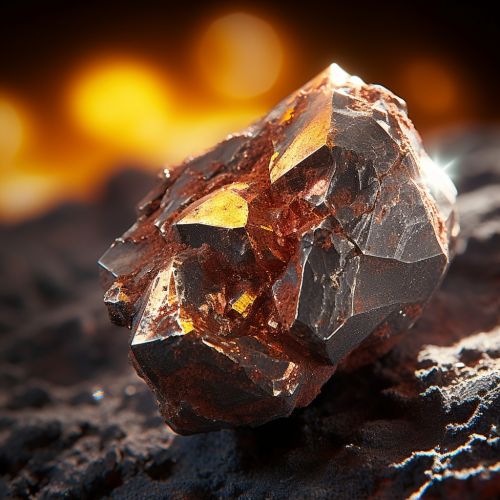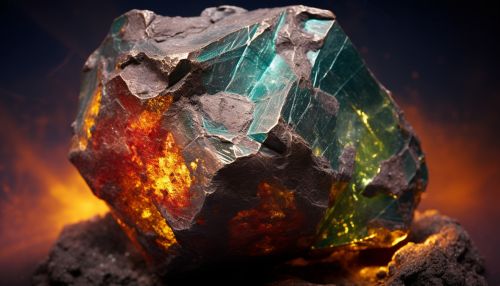Mineralogy of Meteorites
Introduction
Meteorites, the extraterrestrial objects that survive their journey through the Earth's atmosphere and land on the Earth's surface, are invaluable sources of information about the early solar system and the processes that led to the formation of planets. The mineralogy of meteorites, the study of the minerals found within these objects, is a specialized field of geology and astrophysics.


Classification of Meteorites
Meteorites are classified into three broad categories: stony meteorites, iron meteorites, and stony-iron meteorites. Each of these categories has a unique mineral composition, which provides clues about the meteorite's origin and history.
Stony Meteorites
Stony meteorites, also known as chondrites, are the most common type of meteorite. They are primarily composed of silicate minerals, including olivine and pyroxene, and often contain small, spherical inclusions known as chondrules. Chondrites are further divided into ordinary chondrites, carbonaceous chondrites, and enstatite chondrites, each with a distinct mineral composition.
Iron Meteorites
Iron meteorites, as their name suggests, are primarily composed of iron-nickel alloys. These meteorites are believed to originate from the cores of planetesimals, the building blocks of planets. The most common minerals in iron meteorites are kamacite and taenite, both iron-nickel alloys, and they often display a unique crystalline pattern known as a Widmanstätten pattern.
Stony-Iron Meteorites
Stony-iron meteorites are a rare type of meteorite that contains roughly equal amounts of silicate minerals and iron-nickel alloys. The two main types of stony-iron meteorites are mesosiderites and pallasites. Mesosiderites consist of a mixture of metal and silicate minerals, while pallasites contain olivine crystals embedded in a matrix of metal.
Mineral Composition of Meteorites
The mineral composition of a meteorite provides important clues about its origin and history. For example, the presence of certain minerals can indicate that the meteorite originated from a body that was large enough to undergo differentiation, a process in which a planetesimal's heavier materials sink to its core while lighter materials rise to its surface.
Silicate Minerals
Silicate minerals, which are composed of silicon and oxygen, are the most common type of mineral found in stony meteorites. These minerals include olivine, pyroxene, and feldspar. Olivine and pyroxene are often found in the form of chondrules, small, spherical inclusions that are believed to have formed from rapidly cooling droplets of molten rock in the early solar system.
Metal Alloys
Metal alloys, particularly iron-nickel alloys, are the primary component of iron meteorites and are also found in stony-iron meteorites. The most common iron-nickel alloys in meteorites are kamacite and taenite. Kamacite, which contains less nickel than taenite, often forms a unique crystalline pattern known as a Widmanstätten pattern when it cools slowly.
Other Minerals
In addition to silicate minerals and metal alloys, meteorites can contain a variety of other minerals. For example, carbonaceous chondrites often contain organic compounds, including amino acids, which are the building blocks of proteins. Some meteorites also contain presolar grains, tiny particles of stardust that predate the formation of the solar system.
Techniques for Studying the Mineralogy of Meteorites
The mineralogy of meteorites is studied using a variety of techniques, including optical microscopy, electron microscopy, X-ray diffraction, and mass spectrometry. These techniques allow scientists to identify the minerals present in a meteorite and to determine their chemical composition and crystal structure.
Optical Microscopy
Optical microscopy is a basic technique used to study the mineralogy of meteorites. By examining a thin section of a meteorite under a microscope, scientists can identify different minerals based on their color, shape, and the way they interact with light.
Electron Microscopy
Electron microscopy, which uses a beam of electrons instead of light to image a sample, provides a much higher resolution than optical microscopy. This allows scientists to study the fine details of a meteorite's mineral structure, including the size and shape of individual grains.
X-Ray Diffraction
X-ray diffraction is a technique used to determine the crystal structure of a mineral. By analyzing the way X-rays are diffracted, or scattered, by a mineral, scientists can determine the arrangement of atoms within the mineral and identify it.
Mass Spectrometry
Mass spectrometry is a technique used to determine the chemical composition of a mineral. By ionizing a sample and measuring the mass-to-charge ratio of the resulting ions, scientists can identify the elements present in the mineral and their relative abundances.
Conclusion
The mineralogy of meteorites provides invaluable insights into the early solar system and the processes that led to the formation of planets. By studying the minerals found in meteorites, scientists can learn about the conditions that existed in the early solar system, the composition of the bodies from which the meteorites originated, and the processes that led to their formation.
See Also
References
Unfortunately, there are no references available for this article at the moment.
